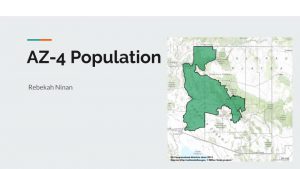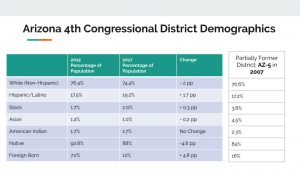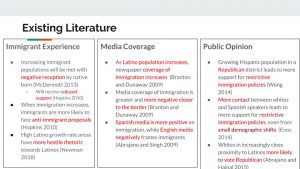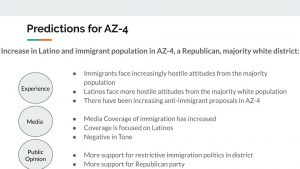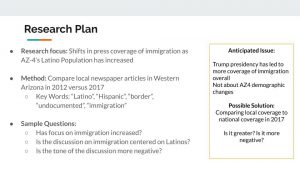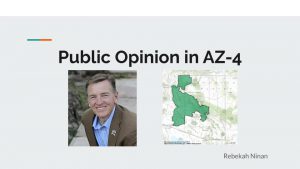
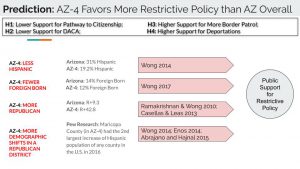
Slide One
In this assignment, I study whether or not public opinion in Arizona-4 actually differs from the rest of Arizona in the way that the literature would predict. My prediction is that public opinion data will reveal that AZ-4 residents have more restrictive immigration policy preferences than other residents in Arizona. There are several factors that lead to this prediction. First, the district is less Hispanic than the state of Arizona overall (19.2% in AZ-4 vs. 31% in AZ). Wong (2014) predicts that this leads to people being in favor of more restrictive immigration policies. Next, the district has fewer foreign-born individuals than the state as a whole which Wong (2017) identifies as a predictor of restrictive immigration policy. Next, the district is more republican than the state as a whole. The state of Arizona does lean right, but AZ-4 is more Republican by a much wider margin. Furthermore, the district’s representative is Republican and highly conservative, whereas one of Arizona’s senators is a Democrat. Based on Casellas and Leas’s 2013 study, this should predict more votes for restrictive immigration policy at the national level. Ramakrishnan and Wong (2010) also find that this leads to more support for restrictive immigration policy at the local level. Finally, while the Pew Research Center finds that Hispanic population is growing in Arizona as a whole, it also identifies that the rate of growth is among the fastest in AZ-4 in recent years, with Maricopa County having the 2nd largest increase of Hispanic population of any county in the US in 2016. Multiple studies predict that such demographic shifts in a Republican district leads to public support for restrictive immigration policies. I articulate these predictions as four hypotheses.
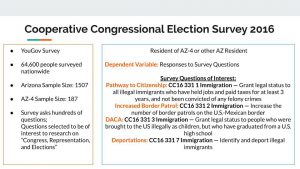
Slide 2
This slide provides details about the data used in this project. I used provided data from the CCES 2016 to study public opinion in Arizona’s fourth congressional district versus the rest of the state. The data is from a consortium of universities using the YouGov Survey to study questions of interest on research on “Congress, Representation, and Elections”. The survey asks hundreds of questions, surveying 64,600 individuals nationwide. The sample size for the state of Arizona is 1507 people and for my district it is 187 people. I am attempting to see if the district has an impact on attitudes on immigration expressed by individuals. I focus on particular questions from the survey that are related to attitudes on immigration. This includes questions that measure support for a pathway to citizenship, support for border patrol, support for DACA, and support for deportations. The exact wording of these questions are detailed on the slide.
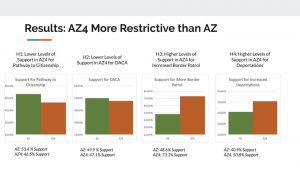
Slide 3:
This slide provides the results of my research in the form of descriptive statistics. I analyzed what percentage of people answered “yes” for the four specified research questions in the CCES survey. I use this percentage to measure the level of support for various policies both of people in the district and people in the state as a whole. I find that the district has lower levels of support for the pathway to citizenship, lower levels of support for DACA, higher levels of support for increased border control, and higher levels of support for deportation than the state of Arizona as a whole. These four findings provide evidence for my four hypotheses. This illustrates that public opinion in AZ4 is more in favor of restrictive immigration policy than Arizona as a whole. The exact percentages are written on the respective slide.
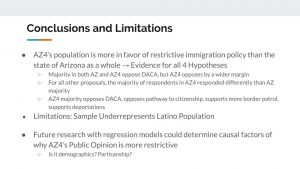
Slide 4:
In this slide, I provide some overall conclusions and limitations of the project. Overall, the descriptive statistics revealed in this project illustrate that in line with the literature on partisanship, latino born populations, foreign populations, and demographic shifts, Arizona-4 has more restrictive views on immigration that the state of Arizona as a whole. This confirms the prediction I articulated, which I confirm through four hypotheses. While this project provides interesting evidence in favor of my prediction, it does not illustrate through which causal mechanism the relationship between the district and public opinion is shaped, though I have theoretically identified four possible pathways. Future research could address this through regressions or other forms of statistical analysis. Another limitation is the survey data itself as it systematically underrepresented the Latino population, which may skew the results. Future research could use other survey data to correct for this issue.
